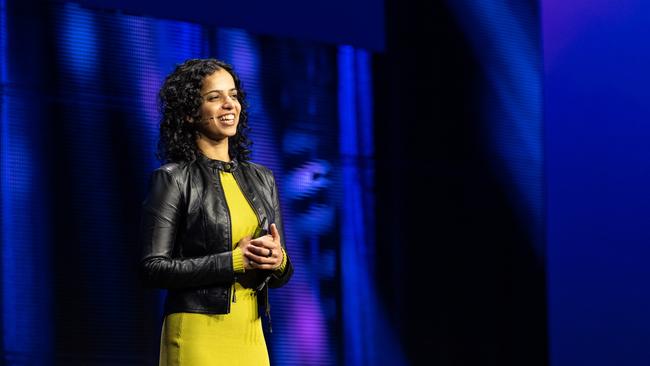‘More than a souped-up chatbot’: Atlassian ups ante in AI race against Microsoft and Google
The software giant has launched a new artificial intelligence product which connects all company data and software as it moves to further differentiate itself from Microsoft and Google.

Australian enterprise software giant Atlassian has unveiled an advanced artificial intelligence product which it says will turbocharge efficiency for its more than 300,000 customers and differentiate itself from Microsoft and Google in the AI race.
Dubbed Rovo, the new product offers a platform to build AI “agents”, allowing companies to draw insights with “piles of raw data scattered across their systems”, turning “information into action in a heartbeat”.
It can strengthen remote working by tracking corporate goals and objectives in real time, rather than waiting for six-monthly performance reviews, via basic verbal prompts.
The move puts Atlassian – which has a market value of $US44.7bn ($69.04bn) head to head with Microsoft and Google.
Microsoft has become the world’s most valuable company, worth $US2.89 trillion, after it unleashed its AI Copilot across a raft of Australian companies, from the big banks to engineering firms.
Google, meanwhile, is aggressively targeting a greater share of the enterprise AI market.
But Atlassian co-chief executive Mike Cannon-Brookes said Rovo was different to Microsoft and Google’s products and that it was more than a “souped-up version of chatbots”, making Atlassian unique.
The unveiling has come after his Atlassian co-founder, Scott Farquhar, announced he would step down as co-CEO in August.
“Google and Microsoft have different ambitions than we do,” Mr Cannon-Brookes said at the company’s annual team event in Las Vegas.
“We focus on teamwork. We’re very much focused on making your teams productive. Every one of our customers would have Microsoft Word or Gmail, or whatever.
“But an AI tool still has to have a core. You can use Google’s to read your Gmail. Well, we don’t make an email client. We’re not trying to do that sort of communication in a broad scale way.
“Neither of them (Microsoft and Google) really have a project management tool, for example, so we do a lot of things in that area.”

To strengthen its offering, Atlassian has quietly recruited several former senior Microsoft employees, including Jamil Valliani, who is now the head of product at Atlassian Intelligence – the company’s AI arm that was launched last year.
Atlassian’s product is specifically aimed at making teams – rather than just individual employees – more productive. Rovo will pull data from Atlassian’s project management software, including Jira, Confluence and Trello, and a company’s HR system and other software such as Microsoft SharePoint, Google Workspaces and Slack.
This creates what Mr Cannon-Brookes called a “teamwork graph”, which he said was Rovo’s “secret sauce”, “unlocking a comprehensive view of your organisation’s goals, knowledge, teams, and work”.
“The model nature of work is a series of unconnected concepts, unconnected documents. You might have to use a messenger like Slack or Teams or something. You’re sending messages over here, using Word over here,” he said.
“You got spreadsheets, emails, Zoom meetings, you’ve got all this stuff happening. And the world doesn’t do a good job of connecting it all.”
He said this was the problem the teamwork graph was designed to solve. “We have billions of companies’ objects tracked and we’re constantly connecting, referencing and de-referencing … which is a fundamental differentiator for us we believe, compared to other companies that either don’t have as much data or haven’t thought as much about how all that data is connected,” he said.
The platform has three key elements: search or finding relevant company data; learning or gaining greater insights from that information; and action, which involves developing AI agents to perform time-consuming tasks.
Like Microsoft’s Copilot, Rovo can generate a raft of content such as producing social media posts and summarising corporate reports.
Atlassian has also worked with another Australian tech darling, visual communications company Canva, to streamline the AI-powered production of marketing content which complies with a business’s brand and other guidelines.
“You can go into Canva and make an image yourself. We can play with Canva at an API level, and then create an agent that can operate Canva, in this case, to do some sort of image processing,” Mr Cannon-Brookes said.
“Maybe that person could go straight to Canva and do that. That’s not necessarily going to be super accurate if they do it themselves. Our agent can listen to that request effectively and says okay, you want a social media image, I can help with this.
“The prompting that goes up to Canva is like three pages long because it’s really detailed. And then it comes back and it looks a lot more like what you want.
“The marketing team’s more comfortable because they know that that’s meeting brand guidelines, and the person is happy because they get things quicker. And that’s like, I guess, one example of many agents that you could deploy, like we think you’ll have thousands of AI-driven agents running around your company to do tasks that just make life a lot quicker and faster.”
Atlassian president Anu Bharadwaj said that since she took on the role last year she committed to talk to at least two customers a week and relay feedback to the company.
She said the top requests were not just to provide feedback but a way of working. “They were really asking what makes teams work well, no matter the context,” Ms Bharadwaj said.
“We’ve seen millions of things over the last few decades and some things really stand out no matter whether you’re a brilliant coffee shop, or you’re building the Mars Rover at NASA, some things are universal.”
“So we want to provide you a system of work that is independent of whether you use a bunch of Microsoft tools, a bunch of Google tools and a bunch of Atlassian tools together. What we want customers to have is a solid foundation for teamwork, which is open by default. So if you want to connect to a third party, it is no problem.”
Mr Valliani, who joined Atlassian last October after more than 20 years at Microsoft, said he envisaged an AI ecosystem involving companies using several models.
“I think every vendor is going to have their areas of specialisation and what we can offer is a unique differentiator,” Mr Valliani said.
“For Atlassian, a lot of our experiences in that teamwork graph is that we understand how people get work done.”
The author travelled to Las Vegas as a guest of Atlassian







To join the conversation, please log in. Don't have an account? Register
Join the conversation, you are commenting as Logout